Body Attachments and Extensions for DIY Cerna® Systems
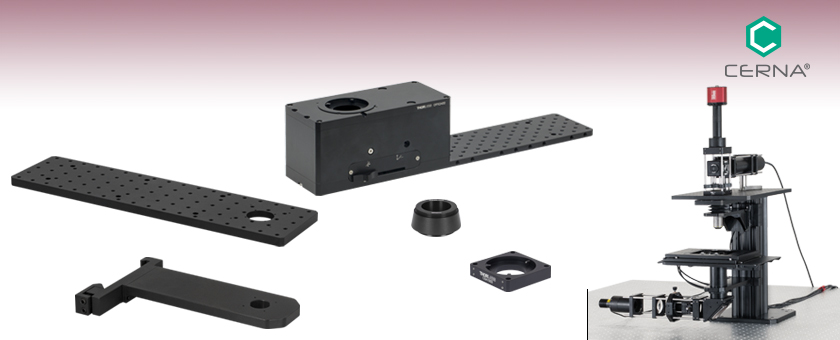
- Use Thorlabs' Construction Systems with DIY Cerna® Systems
- Lens Tube, Cage System, and Dovetail Adapters
- Breadboard Mounting Surfaces and Motorized Z-Axis Translators
CSA3010
18.00" x 4.60" Breadboard Top
CSA1001
Fixed Arm with SM1 and 30 mm Cage Compatibility
WFA4111
SM2 to D1N Adapter
OPX2400
Breadboard Top with Two-Position Slider
Application Idea
DIY Cerna System with 18.00" x 4.60" Breadboard Top and Fixed Arms.
CSA1003
60 mm Cage to D1N Adapter

Please Wait
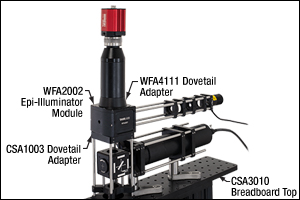
Click to Enlarge
This DIY Cerna® system uses several body attachments and extensions to support a home-built sample viewing and epi-illumination apparatus.
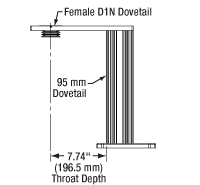
Click to Enlarge
Our DIY Cerna Microscope Bodies with Epi-Illumination Arms offer a 95 mm wide dovetail for holding fixed and motorized arms, and a female D1N dovetail that sets a 7.74" throat depth.
| Quick Links | |
|---|---|
| For 95 mm Dovetail | Fixed Arms Manual Translation Arms Motorized Translation Arms Mounting Platforms |
| For Epi-Illumination Arm | Breadboard Tops Breadboard Top with Two-Position Slider Epi-llluminator Module for One Filter Cube |
| For Trinocular Eyepiece | Eyepiece Adapter |
| Dovetail Adapters | D1N, D2N, D2NB, D3N, D1T, D3T, and D5Y |
Features
- Fixed Arms Position Lens Tubes and Cage Systems at 7.74" Throat Depth
- Manual and Motorized Modules Translate Lens Tubes and Cage Systems Along
Optical Axis - 95 mm Rail Mounting Platforms Attach User-Designed Modules to Microscope Body
- Breadboard Tops Support Home-Built Sample Viewing and Illumination Pathways
- Epi-Illuminator Module Integrates Filter Cubes with SM1 and 30 mm Cage Components
- Eyepiece Adapter for Mounting Detection Systems to Trinocular Eyepieces
- Dovetail Adapters Connect DIY Cerna® Components to Lens Tubes and Cage Systems
The items on this webpage integrate Thorlabs' lens tube systems, cage construction systems, and other optomechanics with our Cerna microscopy platform.
We offer several types of arms that center lens tubes and/or cage construction systems along an optical axis 7.74" away from the edge of a Cerna microscope body. Some arms can be directly attached to the vertical rail to provide structural support for these construction systems, while others can be connected to a manual or motorized module to enable 1" of travel along the optical axis.
In addition, we manufacture breadboard tops with optical ports centered on a male D1N dovetail. These breadboards provide 1/4"-20 (M6 x 1.0) tapped hole arrays that mount to the female D1N dovetail on a Cerna microscope body's epi-illumination arm, which can be used to create optomechanical setups. A version with a manual two-position slider is also offered that provides the ability to select between and combine optical paths.
Our 95 mm rail mounting platforms permit user-designed modules to be mounted anywhere along the sides of the vertical rail. An epi-illuminator module that interfaces our SM1 lens tube and 30 mm cage system to a fluorescence filter cube is available. An eyepiece adapter and dovetail adapters that connect a wide range of DIY Cerna components to lens tubes and cage systems are also shown below.
The Microscope Dovetails tab gives additional information on the dovetails used throughout the Cerna microscopy platform, while the Cage Overview tab gives a brief overview of our cage construction systems.
| Thorlabs Dovetail Referencea | |||
|---|---|---|---|
| Type | Shape | Outer Dimension | Angle |
| 95 mm | Linear | 95 mm | 45° |
| D1N | Circular | Ø2.018" | 60° |
| D2Nb | Circular | Ø1.50" | 90° |
| D2NBb | Circular | Ø1.50" | 90° |
| D3N | Circular | Ø45 mm | 70° |
| D5N | Circular | Ø1.58" | 90° |
| D6N | Circular | Ø1.90" | 90° |
| D7N | Circular | Ø2.05" | 90° |
| D1T | Circular | Ø1.50" | 60° |
| D3T | Circular | Ø1.65" | 90° |
| D1Y | Circular | Ø107 mm | 60° |
| D2Y | Circular | Ø2.32" | 50° |
| D3Y | Circular | Ø1.75" | 90° |
| D4Y | Circular | Ø56 mm | 60° |
| D5Y | Circular | Ø46 mm | 60° |
| D6Y | Circular | Ø41.9 mm | 45° |
| D1Z | Circular | Ø54 mm | 60° |
| D2Z | Circular | Ø57 mm | 60° |
| D3Z | Circular | Ø54 mm | 45° |
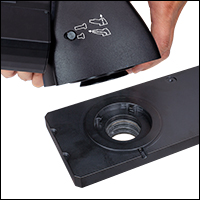
Click to Enlarge
This photo shows the male D1N dovetail on the trinoculars next to the female D1N dovetail on the epi-illumination arm.
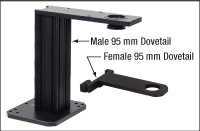
Click to Enlarge
This photo shows the male 95 mm dovetail on the microscope body and the female 95 mm dovetail on the CSA1002 Fixed Arm.
Introduction to Microscope Dovetails
Dovetails are used for mechanical mating and optical port alignment of microscope components. Components are connected by inserting one dovetail into another, then tightening one or more locking setscrews on the female dovetail. Dovetails come in two shapes: linear and circular. Linear dovetails allow the mating components to slide before being locked down, providing flexible positioning options while limiting unneeded degrees of freedom. Circular dovetails align optical ports on different components, maintaining a single optical axis with minimal user intervention.
Thorlabs manufactures many components which use dovetails to mate with our own components or those of other manufacturers. To make it easier to identify dovetail compatibility, we have developed a set of dovetail designations. The naming convention of these designations is used only by Thorlabs and not other microscope manufacturers. The table to the right lists all the dovetails Thorlabs makes, along with their key dimensions.
In the case of Thorlabs’ Cerna® microscopes, different dovetail types are used on different sections of the microscope to ensure that only compatible components can be mated. For example, our WFA2002 Epi-Illuminator Module has a male D1N dovetail that mates with the female D1N dovetail on the microscope body's epi-illumination arm, while the CSS2001 XY Microscopy Stage has a female D1Y dovetail that mates with the male D1Y dovetail on the CSA1051 Mounting Arm.
To learn which dovetail type(s) are on a particular component, consult its mechanical drawing, available by clicking on the red Docs icon (![]() ) below. For adapters with a female dovetail, the drawing also indicates the size of the hex key needed for the locking setscrew(s). It is important to note that mechanical compatibility does not ensure optical compatibility. Information on optical compatibility is available from Thorlabs' web presentations.
) below. For adapters with a female dovetail, the drawing also indicates the size of the hex key needed for the locking setscrew(s). It is important to note that mechanical compatibility does not ensure optical compatibility. Information on optical compatibility is available from Thorlabs' web presentations.
For customers interested in machining their own dovetails, the table to the right gives the outer diameter and angle (as defined by the drawings below) of each Thorlabs dovetail designation. However, the dovetail's height must be determined by the user, and for circular dovetails, the user must also determine the inner diameter and bore diameter. These quantities can vary for dovetails of the same type. One can use the intended mating part to verify compatibility.
In order to reduce wear and simplify connections, dovetails are often machined with chamfers, recesses, and other mechanical features. Some examples of these variations are shown by the drawings below.

Click to Enlarge
Two examples of how circular male dovetails can be manufactured.

Click to Enlarge
Two examples of how circular female dovetails can be manufactured.
Standard Mechanical Interfaces on DIY Cerna® Components
The table below gives the dovetail, optical component threads, and cage system interfaces that are present on each DIY Cerna component. If a DIY Cerna component does not have one of the standard interfaces in the table, it is not listed here. Please note that mechanical compatibility does not ensure optical compatibility. Information on optical compatibility is available from Thorlabs' web presentations.
| Item # | Microscope Dovetails | Optical Component Threadsa | Cage Systemsb | ||||||||||
|---|---|---|---|---|---|---|---|---|---|---|---|---|---|
| 95 mm | D1N | D2N | D2NB | D3N | D5N | D1T | D3T | D1Y | D5Y | Internal | External | ||
| 2CM1 | - | - | - | - | - | - | - | - | - | - | SM1c (1.035"-40) and SM2d (2.035"-40) | SM1c (1.035"-40) | 60 mmd |
| 2CM2 | - | - | - | - | - | - | - | - | - | - | SM1c (1.035"-40) and SM2d (2.035"-40) | SM1c (1.035"-40) | 30 mmc |
| BSA2000e | - | - | - | - | Female | - | - | - | - | - | - | - | - |
| CEA1350 | Male | Female | - | - | - | - | - | - | - | - | - | - | 60 mmd |
| CEA1400 | Male | Female | - | - | - | - | - | - | - | - | - | - | 60 mmd |
| CEA1500 | Male | Female | - | - | - | - | - | - | - | - | - | - | 60 mmd |
| CEA1600 | Male | Female | - | - | - | - | - | - | - | - | - | - | 60 mmd |
| CFB1500 | Male | - | - | - | - | - | - | - | - | - | - | - | - |
| CSA1000 | Female | - | - | - | - | - | - | - | - | - | - | - | - |
| CSA1001 | Female | - | - | - | - | - | - | - | - | - | SM1c (1.035"-40) | - | 30 mmc |
| CSA1002 | Female | - | - | - | - | - | - | - | - | - | SM2d (2.035"-40) | - | 60 mmd |
| CSA1003 | - | Female | - | - | - | - | - | - | - | - | - | - | 60 mmd |
| CSA1051 | Female | - | - | - | - | - | - | - | Male | - | - | - | - |
| CSA1200e,f | - | - | - | - | - | - | - | - | - | - | - | - | 60 mmd |
| CSA1400e | - | - | - | - | - | - | Female | - | - | - | - | - | 60 mmd |
| CSA1500e,g | - | - | - | - | - | - | - | - | - | - | - | - | - |
| CSA2000e | - | - | - | - | Female | - | - | - | - | - | SM2d (2.035"-40) | - | 60 mmd |
| CSA2001 | - | - | - | - | Female | - | - | - | - | - | - | SM2d (2.035"-40) | - |
| CSA2100e | - | - | - | - | - | - | - | - | - | - | SM2d (2.035"-40) | - | 60 mmd |
| CSA3000(/M) | - | Male | - | - | - | - | - | - | - | - | - | - | - |
| CSA3010(/M) | - | Male | - | - | - | - | - | - | - | - | - | - | 30 mmc and 60 mmd |
| Item # | 95 mm | D1N | D2N | D2NB | D3N | D5N | D1T | D3T | D1Y | D5Y | Internal | External | Cage Systems |
| CSC1001 | - | - | - | - | Male | - | - | - | - | - | - | - | - |
| CSC1002 | - | - | - | - | Male | - | - | - | - | - | - | - | - |
| CSC2001 | - | - | - | - | Male | - | - | - | - | - | - | - | - |
| CSD1001 | - | Male & Female | - | Female | - | - | - | - | - | - | - | - | - |
| CSD1002 | - | Male & Female | - | - | - | - | - | - | - | - | - | C-Mounth | - |
| CSE2000 | - | Male & Female | - | - | - | - | - | - | - | - | - | - | 60 mmd |
| CSE2100 | - | Male & Female | - | - | - | - | - | Female | - | - | SM1c (1.035"-40) | - | 30 mmc and 60 mmd |
| CSE2200 | - | Male & Female | - | - | - | - | - | Female | - | - | SM1c (1.035"-40) | - | 30 mmc and 60 mmd |
| CSN100e | - | - | - | - | - | - | - | - | - | - | M32 x 0.75 | - | 60 mmd |
| CSN110 | - | - | - | - | - | - | Male | - | - | - | M32 x 0.75 | - | 30 mmc and 60 mmd |
| CSNK10 | - | - | - | - | - | - | - | - | - | - | M32 x 0.75 | - | 60 mmd |
| CSNK100e | - | - | - | - | - | - | - | - | - | - | M32 x 0.75 | - | 60 mmd |
| CSN200 | - | - | - | - | - | - | Male | - | - | - | M32 x 0.75 | - | - |
| CSN210 | - | - | - | - | - | - | Male | - | - | - | M32 x 0.75 | - | - |
| CSN1201f | - | - | - | - | - | - | - | - | - | - | M32 x 0.75 | - | - |
| CSN1202f | - | - | - | - | - | - | - | - | - | - | M25 x 0.75 | - | - |
| CSS2001 | - | - | - | - | - | - | - | - | Female | - | - | - | - |
| LAURE1 | - | Male | Female | - | - | - | - | - | - | - | - | - | - |
| LAURE2 | - | Male | Female | - | - | - | - | - | - | - | - | - | - |
| LCPN1 | - | - | - | - | Male | - | - | - | - | - | SM30 (M30.5 x 0.5) | - | 30 mmc and 60 mmd |
| LCPN2 | - | Male | - | - | - | - | - | - | - | - | SM30 (M30.5 x 0.5) | - | 30 mmc and 60 mmd |
| Item # | 95 mm | D1N | D2N | D2NB | D3N | D5N | D1T | D3T | D1Y | D5Y | Internal | External | Cage Systems |
| LCPN3 | - | Male | - | - | - | - | - | - | - | Female | SM30 (M30.5 x 0.5) | - | 60 mmd |
| LCPN4 | - | Male | - | - | - | - | - | - | - | - | SM2d (2.035"-40) | - | 60 mmd |
| LCPN5 | - | - | - | - | Male | - | - | - | - | - | SM2d (2.035"-40) | - | 60 mmd |
| LCPN6 | - | - | Female | - | - | - | - | - | - | - | SM1c (1.035"-40) | - | 30 mmc and 60 mmd |
| LCPY2 | - | - | - | - | - | - | - | - | - | Male | SM30 (M30.5 x 0.5) | - | 30 mmc and 60 mmd |
| LCPY3 | - | - | - | - | - | - | - | - | - | Female | - | - | 30 mmc and 60 mmd |
| OPX2400(/M) | - | Male & Female | - | - | - | - | - | - | - | - | SM2d (2.035"-40) | - | 60 mmd |
| SM1A70 | - | - | - | - | - | - | - | - | - | - | SM30 (M30.5 x 0.5) | SM1c (1.035"-40) | - |
| SM1A58 | - | - | Male | Male | - | - | - | - | - | - | SM1c (1.035"-40) | SM2d (2.035"-40) | 30 mmc |
| SM2A56 | - | - | - | - | - | - | - | Male | - | - | - | SM2d (2.035"-40) | - |
| SM2A59 | - | Male | - | - | - | - | - | - | - | - | SM2d (2.035"-40) | - | - |
| TC1X | - | - | Male | - | - | - | - | - | - | - | - | - | - |
| WFA0150 | Female | - | - | - | - | - | - | - | - | - | - | - | - |
| WFA1000 | - | - | - | - | - | - | - | - | - | - | - | - | 30 mmc |
| WFA1010 | - | - | - | - | - | - | - | - | - | - | SM1c (1.035"-40) | - | 30 mmc |
| WFA1020 | - | - | - | - | - | - | - | - | - | - | SM1c (1.035"-40) | - | 30 mmc |
| WFA1051 | - | - | - | - | - | - | - | - | - | - | SM1c (1.035"-40) | - | 30 mmc |
| WFA1100 | - | - | - | - | - | - | - | - | - | - | - | - | 30 mmc |
| WFA2001 | - | Male & Female | - | - | - | - | - | - | - | - | SM1c (1.035"-40) | SM1c (1.035"-40) | - |
| WFA2002 | - | Male & Female | - | - | - | - | - | - | - | - | SM1c (1.035"-40) | - | 30 mmc |
| Item # | 95 mm | D1N | D2N | D2NB | D3N | D5N | D1T | D3T | D1Y | D5Y | Internal | External | Cage Systems |
| WFA4100 | - | Male | - | - | - | - | - | - | - | - | SM1c (1.035"-40) | C-Mounth | - |
| WFA4101 | - | Male | - | - | - | - | - | - | - | - | SM1c (1.035"-40) | C-Mounth | - |
| WFA4102 | - | Male | - | - | - | - | - | - | - | - | SM1c (1.035"-40) | C-Mounth | - |
| WFA4111 | - | Male | - | - | - | - | - | - | - | - | - | SM2d (2.035"-40) | - |
| WFA4112 | - | - | - | Male | - | - | - | - | - | - | - | C-Mounth | - |
| Female | - | - | - | - | - | - | - | - | - | - | - | - | |
| Female | - | - | - | - | - | - | - | - | - | - | - | - | |
| Female | - | - | - | - | - | - | - | - | - | - | - | - | |
| Female | - | - | - | - | - | - | - | - | - | - | - | - | |
| XT95P12(/M) | Female | - | - | - | - | - | - | - | - | - | - | - | - |
| ZFM1020 | Female | - | - | - | - | - | - | - | - | - | - | - | - |
| ZFM1030 | Female | - | - | - | - | - | - | - | - | - | - | - | - |
| ZFM2020 | Female | - | - | - | - | - | - | - | - | - | - | - | - |
| ZFM2030 | Female | - | - | - | - | - | - | - | - | - | - | - | - |
Cage System Overview
The Cage Assembly System provides a convenient way to construct large optomechanical systems with an established line of precision-machined building blocks designed for high flexibility and accurate alignment.
16 mm, 30 mm, and 60 mm Cage System Standards
Thorlabs offers three standards defined by the center-to-center spacing of the cage assembly rods (see image below). The 16 mm cage, 30 mm cage, and 60 mm cage standards are designed to accommodate Ø1/2", Ø1", and Ø2" optics, respectively. Specialized cage plates that allow smaller optics to be directly inserted into our larger cage systems are also available.
Standard Threads
The flexibility of our Cage Assembly System stems from well-defined mounting and thread standards designed to directly interface with a wide range of specialized products. The three most prevalent thread standards are our SM05 Series (0.535"-40 thread), SM1 Series (1.035"-40 thread), and SM2 Series (2.035"-40 thread), all of which were defined to house the industry's most common optic sizes. Essential building blocks, such as our popular lens tubes, directly interface to these standards.

An example of the standard cage plate measurements determining cage system compatibility.
| Standard Cage System Measurements | |||
|---|---|---|---|
| Cage System | 16 mm | 30 mm | 60 mm |
| Thread Series | SM05 | SM1 | SM2 |
| Rod to Rod Spacing | 16 mm (0.63") | 30 mm (1.18") | 60 mm (2.36") |
| Total Length | 25 mm (0.98") | 41 mm (1.60") | 71.1 mm (2.80") |
| Cage Components | ||
|---|---|---|
| Cage Rods | 16 mm | These rods are used to connect cage plates, optic mounts, and other components in the cage system. The SR Series Cage Rods are compatible with our 16 mm cage systems, while the 30 mm and 60 mm cage systems use ER Series Cage Rods. |
| 30 mm | ||
| 60 mm | ||
| Cage Plates | 16 mm | These serve as the basic building blocks for a cage system. They may have SM-threaded central bores, smooth bores sized for industry standard optics or to accommodate the outer profile of our SM Series Lens Tubes, or specialized bores for other components such as our FiberPorts. |
| 30 mm | ||
| 60 mm | ||
| Optic Mounts | 16 mm | Thorlabs offers fixed, kinematic, rotation, and translation mounts specifically designed for our Cage Systems. |
| 30 mm | ||
| 60 mm | ||
| Cage Cubes | 16 mm | These cubes are useful for housing larger optical components, such as prisms or mirrors, or optics that need to sit at an angle to the beam path, such as beamsplitters. Our cage cubes are available empty or with pre-mounted optics. |
| 30 mm | ||
| 60 mm | ||
| Replacement Setscrews | Replacement setscrews are offered for our 16 mm (SS4B013, SS4B025, and SS4B038) and 30 mm (SS4MS5 and SS4MS4) cage systems products. | |
| Post and Breadboard Mounts and Adapters | Mounting options for cage systems can be found on our Cage System Construction pages. Cage Systems can be mounted either parallel or perpendicular to the table surface. | |
| Size Adapters | Cage System Size Adapters can be used to integrate components from different cage system and threading standards. | |
| Specialized Components | Thorlabs also produces specialized cage components, such as Filter Wheels, a HeNe Laser Mount, and a FiberPort Cage Plate Adapter, allowing a wide range of our products to be integrated into cage-mounted optical systems. Explore our Cage Systems Visual Navigation Guide to see the full range of Thorlabs' cage components. | |
| SM05 Threading: Ø1/2" Lens Tubes, 16 mm Cage Systems | |||
|---|---|---|---|
| External Thread, 0.535"-40.0 UNS-2A | Internal Thread, 0.535"-40.0 UNS-2B | ||
| Max Major Diameter | 0.5340" | Min Major Diameter | 0.5350" |
| Min Major Diameter | 0.5289" | Min Pitch Diameter | 0.5188" |
| Max Pitch Diameter | 0.5178" | Max Pitch Diameter | 0.5230" |
| Min Pitch Diameter | 0.5146" | Min Minor Diameter (and 83.3% of Thread) | 0.508" |
| Max Minor Diameter | 0.5069" | Max Minor Diameter (and 64.9% of Thread) | 0.514" |
| RMS Threading: Objective, Scan, and Tube Lenses | |||
|---|---|---|---|
| External Thread, 0.800"-36.0 UNS-2A | Internal Thread, 0.800"-36.0 UNS-2B | ||
| Max Major Diameter | 0.7989" | Min Major Diameter | 0.8000" |
| Min Major Diameter | 0.7934" | Min Pitch Diameter | 0.7820" |
| Max Pitch Diameter | 0.7809" | Max Pitch Diameter | 0.7866" |
| Min Pitch Diameter | 0.7774" | Min Minor Diameter (and 83.3% of Thread) | 0.770" |
| Max Minor Diameter | 0.7688" | Max Minor Diameter (and 64.9% of Thread) | 0.777" |
| C-Mount Threading: Machine Vision Lenses, CCD/CMOS Cameras | |||
|---|---|---|---|
| External Thread, 1.000"-32.0 UN-2A | Internal Thread, 1.000"-32.0 UN-2B | ||
| Max Major Diameter | 0.9989" | Min Major Diameter | 1.0000" |
| Min Major Diameter | 0.9929" | Min Pitch Diameter | 0.9797" |
| Max Pitch Diameter | 0.9786" | Max Pitch Diameter | 0.9846" |
| Min Pitch Diameter | 0.9748" | Min Minor Diameter (and 83.3% of Thread) | 0.966" |
| Max Minor Diameter | 0.9651" | Max Minor Diameter (and 64.9% of Thread) | 0.974" |
| SM1 Threading: Ø1" Lens Tubes, 30 mm Cage Systems | |||
|---|---|---|---|
| External Thread, 1.035"-40.0 UNS-2A | Internal Thread, 1.035"-40.0 UNS-2B | ||
| Max Major Diameter | 1.0339" | Min Major Diameter | 1.0350" |
| Min Major Diameter | 1.0288" | Min Pitch Diameter | 1.0188" |
| Max Pitch Diameter | 1.0177" | Max Pitch Diameter | 1.0234" |
| Min Pitch Diameter | 1.0142" | Min Minor Diameter (and 83.3% of Thread) | 1.008" |
| Max Minor Diameter | 1.0068" | Max Minor Diameter (and 64.9% of Thread) | 1.014" |
| SM30 Threading: Ø30 mm Lens Tubes | |||
|---|---|---|---|
| External Thread, M30.5 x 0.5 – 6H/6g | Internal Thread, M30.5 x 0.5 – 6H/6g | ||
| Max Major Diameter | 30.480 mm | Min Major Diameter | 30.500 mm |
| Min Major Diameter | 30.371 mm | Min Pitch Diameter | 30.175 mm |
| Max Pitch Diameter | 30.155 mm | Max Pitch Diameter | 30.302 mm |
| Min Pitch Diameter | 30.059 mm | Min Minor Diameter (and 83.3% of Thread) | 29.959 mm |
| Max Minor Diameter | 29.938 mm | Max Minor Diameter (and 64.9% of Thread) | 30.094 mm |
| SM1.5 Threading: Ø1.5" Lens Tubes | |||
|---|---|---|---|
| External Thread, 1.535"-40 UNS-2A | Internal Thread, 1.535"-40 UNS-2B | ||
| Max Major Diameter | 1.5339" | Min Major Diameter | 1.535" |
| Min Major Diameter | 1.5288" | Min Pitch Diameter | 1.5188" |
| Max Pitch Diameter | 1.5177" | Max Pitch Diameter | 1.5236" |
| Min Pitch Diameter | 1.5140" | Min Minor Diameter (and 83.3% of Thread) | 1.508" |
| Max Minor Diameter | 1.5068" | Max Minor Diameter (and 64.9% of Thread) | 1.514" |
| SM2 Threading: Ø2" Lens Tubes, 60 mm Cage Systems | |||
|---|---|---|---|
| External Thread, 2.035"-40.0 UNS-2A | Internal Thread, 2.035"-40.0 UNS-2B | ||
| Max Major Diameter | 2.0338" | Min Major Diameter | 2.0350" |
| Min Major Diameter | 2.0287" | Min Pitch Diameter | 2.0188" |
| Max Pitch Diameter | 2.0176" | Max Pitch Diameter | 2.0239" |
| Min Pitch Diameter | 2.0137" | Min Minor Diameter (and 83.3% of Thread) | 2.008" |
| Max Minor Diameter | 2.0067" | Max Minor Diameter (and 64.9% of Thread) | 2.014" |
| SM3 Threading: Ø3" Lens Tubes | |||
|---|---|---|---|
| External Thread, 3.035"-40.0 UNS-2A | Internal Thread, 3.035"-40.0 UNS-2B | ||
| Max Major Diameter | 3.0337" | Min Major Diameter | 3.0350" |
| Min Major Diameter | 3.0286" | Min Pitch Diameter | 3.0188" |
| Max Pitch Diameter | 3.0175" | Max Pitch Diameter | 3.0242" |
| Min Pitch Diameter | 3.0133" | Min Minor Diameter (and 83.3% of Thread) | 3.008" |
| Max Minor Diameter | 3.0066" | Max Minor Diameter (and 64.9% of Thread) | 3.014" |
| SM4 Threading: Ø4" Lens Tubes | |||
|---|---|---|---|
| External Thread, 4.035"-40 UNS-2A | Internal Thread, 4.035"-40.0 UNS-2B | ||
| Max Major Diameter | 4.0337" | Min Major Diameter | 4.0350" |
| Min Major Diameter | 4.0286" | Min Pitch Diameter | 4.0188" |
| Max Pitch Diameter | 4.0175" | Max Pitch Diameter | 4.0245" |
| Min Pitch Diameter | 4.0131" | Min Minor Diameter (and 83.3% of Thread) | 4.008" |
| Max Minor Diameter | 4.0066" | Max Minor Diameter (and 64.9% of Thread) | 4.014" |
Building a Cerna® Microscope
The Cerna microscopy platform's large working volume and system of dovetails make it straightforward to connect and position the components of the microscope. This flexibility enables simple and stable set up of a preconfigured microscope, and provides easy paths for later upgrades and modification. See below for a couple examples of the assembly of some DIY Cerna microscopes.
DIY Cerna Design and Assembly
Walkthrough of a DIY Microscope Configuration
This DIY microscope uses a CSA3000(/M) Breadboard Top, a CSA2001 Dovetail Adapter, our CSA1001 and CSA1002 Fixed Arms, and other body attachments and extensions. These components provide interfaces to our lens tube and cage construction systems, allowing the rig to incorporate two independent trans-illumination modules, a home-built epi-illumination path, and a custom sample viewing optical path.
The simplicity of Thorlabs optomechanical interfaces allows a custom DIY microscope to be quickly assembled and reconfigured for custom imaging applications.
| Posted Comments: | |
Eric Tai
(posted 2023-03-23 17:14:03.07) The XT95 optical rails have an excellent design for repeatability, but precision is partially lost when using the XT95RC4 because this part doesn't have any holes for dowel pins. It would be great if this part could include dowel pin holes for precision mating of custom parts to this rail carrier. jdelia
(posted 2023-04-17 01:09:50.0) Thank you for contacting Thorlabs, and for providing this valuable feedback! While this is not a feature we currently offer, I could certainly pass along your request to our design engineers through our internal suggestion forum. Matthias Weiß
(posted 2022-09-30 11:08:37.007) Hi, I am trying to figure out how to best mount a cage system to the CSA3000/M, as it is shown on several pictures on the homepage, since the CSA3000/M does not have tapped holes for ER series rods. Using a CPVMP also does not work, as the counterbore slot does not align with the tapped holes. Mounting the cages system only via posts seems inappropriate to me, as a exact alignment is hard to achieve and also not reproducable when compontents are changed. cdolbashian
(posted 2022-10-07 11:28:39.0) Thank you for reaching out to us with this inquiry Matthias. It is indeed a feature lacking on the CSA3000* breadboard. As of now we do not have a direct solution which is as good as a true set of tapped 4-40 cage holes. Hoever, this is something we could do for you as a special! I have contacted you directly to work this out. |
Click on the different parts of the microscope to explore their functions.
Elements of a Microscope
This overview was developed to provide a general understanding of a Cerna® microscope. Click on the different portions of the microscope graphic to the right or use the links below to learn how a Cerna microscope visualizes a sample.
Terminology
Arm: Holds components in the optical path of the microscope.
Bayonet Mount: A form of mechanical attachment with tabs on the male end that fit into L-shaped slots on the female end.
Bellows: A tube with accordion-shaped rubber sides for a flexible, light-tight extension between the microscope body and the objective.
Breadboard: A flat structure with regularly spaced tapped holes for DIY construction.
Dovetail: A form of mechanical attachment for many microscopy components. A linear dovetail allows flexible positioning along one dimension before being locked down, while a circular dovetail secures the component in one position. See the Microscope Dovetails tab or here for details.
Epi-Illumination: Illumination on the same side of the sample as the viewing apparatus. Epi-fluorescence, reflected light, and confocal microscopy are some examples of imaging modalities that utilize epi-illumination.
Filter Cube: A cube that holds filters and other optical elements at the correct orientations for microscopy. For example, filter cubes are essential for fluorescence microscopy and reflected light microscopy.
Köhler Illumination: A method of illumination that utilizes various optical elements to defocus and flatten the intensity of light across the field of view in the sample plane. A condenser and light collimator are necessary for this technique.
Nosepiece: A type of arm used to hold the microscope objective in the optical path of the microscope.
Optical Path: The path light follows through the microscope.
Rail Height: The height of the support rail of the microscope body.
Throat Depth: The distance from the vertical portion of the optical path to the edge of the support rail of the microscope body. The size of the throat depth, along with the working height, determine the working space available for microscopy.
Trans-Illumination: Illumination on the opposite side of the sample as the viewing apparatus. Brightfield, differential interference contrast (DIC), Dodt gradient contrast, and darkfield microscopy are some examples of imaging modalities that utilize trans-illumination.
Working Height: The height of the support rail of the microscope body plus the height of the base. The size of the working height, along with the throat depth, determine the working space available for microscopy.
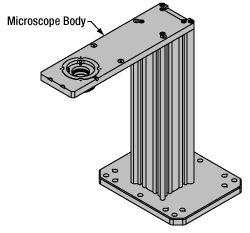 Click to Enlarge
Click to EnlargeCerna Microscope Body
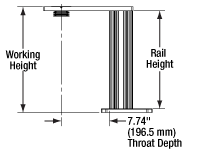
Click to Enlarge
Body Details
Microscope Body
The microscope body provides the foundation of any Cerna microscope. The support rail utilizes 95 mm rails machined to a high angular tolerance to ensure an aligned optical path and perpendicularity with the optical table. The support rail height chosen (350 - 600 mm) determines the vertical range available for experiments and microscopy components. The 7.74" throat depth, or distance from the optical path to the support rail, provides a large working space for experiments. Components attach to the body by way of either a linear dovetail on the support rail, or a circular dovetail on the epi-illumination arm (on certain models). Please see the Microscope Dovetails tab or here for further details.
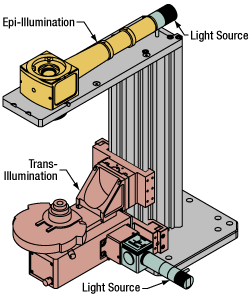 Click to Enlarge
Click to EnlargeIllumination with a Cerna microscope can come from above (yellow) or below (orange). Illumination sources (green) attach to either.
Illumination
Using the Cerna microscope body, a sample can be illuminated in two directions: from above (epi-illumination, see yellow components to the right) or from below (trans-illumination, see orange components to the right).
Epi-illumination illuminates on the same side of the sample as the viewing apparatus; therefore, the light from the illumination source (green) and the light from the sample plane share a portion of the optical path. It is used in fluorescence, confocal, and reflected light microscopy. Epi-illumination modules, which direct and condition light along the optical path, are attached to the epi-illumination arm of the microscope body via a circular D1N dovetail (see the Microscope Dovetails tab or here for details). Multiple epi-illumination modules are available, as well as breadboard tops, which have regularly spaced tapped holes for custom designs.
Trans-illumination illuminates from the opposite side of the sample as the viewing apparatus. Example imaging modalities include brightfield, differential interference contrast (DIC), Dodt gradient contrast, oblique, and darkfield microscopy. Trans-illumination modules, which condition light (on certain models) and direct it along the optical path, are attached to the support rail of the microscope body via a linear dovetail (see Microscope Dovetails tab or here). Please note that certain imaging modalities will require additional optics to alter the properties of the beam; these optics may be easily incorporated in the optical path via lens tubes and cage systems. In addition, Thorlabs offers condensers, which reshape input collimated light to help create optimal Köhler illumination. These attach to a mounting arm, which holds the condenser at the throat depth, or the distance from the optical path to the support rail. The arm attaches to a focusing module, used for aligning the condenser with respect to the sample and trans-illumination module.
 |
 |
 |
 |
 |
 |
 |
 |
| Epi-Illumination Modules | Breadboards & Body Attachments |
Brightfield | DIC | Dodt | Condensers | Condenser Mounting | Light Sources |
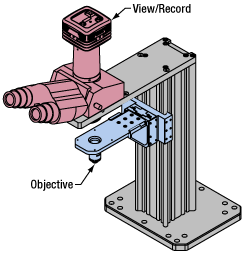 Click to Enlarge
Click to EnlargeLight from the sample plane is collected through an objective (blue) and viewed using trinocs or other optical ports (pink).
Sample Viewing/Recording
Once illuminated, examining a sample with a microscope requires both focusing on the sample plane (see blue components to the right) and visualizing the resulting image (see pink components).
A microscope objective collects and magnifies light from the sample plane for imaging. On the Cerna microscope, the objective is threaded onto a nosepiece, which holds the objective at the throat depth, or the distance from the optical path to the support rail of the microscope body. This nosepiece is secured to a motorized focusing module, used for focusing the objective as well as for moving it out of the way for sample handling. To ensure a light-tight path from the objective, the microscope body comes with a bellows (not pictured).
Various modules are available for sample viewing and data collection. Trinoculars have three points of vision to view the sample directly as well as with a camera. Double camera ports redirect or split the optical path among two viewing channels. Camera tubes increase or decrease the image magnification. For data collection, Thorlabs offers both cameras and photomultiplier tubes (PMTs), the latter being necessary to detect fluorescence signals for confocal microscopy. Breadboard tops provide functionality for custom-designed data collection setups. Modules are attached to the microscope body via a circular dovetail (see the Microscope Dovetails tab or here for details).
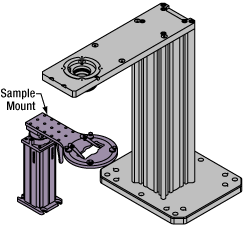 Click to Enlarge
Click to EnlargeThe rigid stand (purple) pictured is one of various sample mounting options available.
Sample/Experiment Mounting
Various sample and equipment mounting options are available to take advantage of the large working space of this microscope system. Large samples and ancillary equipment can be mounted via mounting platforms, which fit around the microscope body and utilize a breadboard design with regularly spaced tapped through holes. Small samples can be mounted on rigid stands (for example, see the purple component to the right), which have holders for different methods of sample preparation and data collection, such as slides, well plates, and petri dishes. For more traditional sample mounting, slides can also be mounted directly onto the microscope body via a manual XY stage. The rigid stands can translate by way of motorized stages (sold separately), while the mounting platforms contain built-in mechanics for motorized or manual translation. Rigid stands can also be mounted on top of the mounting platforms for independent and synchronized movement of multiple instruments, if you are interested in performing experiments simultaneously during microscopy.

- Optical Ports for 7.74" Throat Depth of DIY Cerna Systems
- CSA1001: Internal SM1 (1.035"-40) Threads and Four 4-40 Taps for 30 mm Cage System
- CSA1002: Internal SM2 (2.035"-40) Threads and Four 4-40 Taps for 60 mm Cage System
- 95 mm Dovetail Clamp on Back Connects to Microscope Body
When installed on a Cerna microscope body, our Fixed Arms are designed to position an optical apparatus 7.74" away from the edge of the vertical rail. Designed to provide structural support for user-built optical paths, each has a 95 mm dovetail clamp on the back that can be secured anywhere along the microscope body's linear dovetail surface by tightening two 4 mm hex setscrews.
These fixed arms are offered in three versions. The CSA1001 arm has internal SM1 (1.035"-40) through threads for Ø1" lens tubes and four 4-40 through taps for 30 mm cage systems, while the CSA1002 arm has internal SM2 (2.035"-40) through threads for Ø2" lens tubes and four 4-40 through taps for 60 mm cage systems. The image to the right uses one of each to support a home-built trans-illumination apparatus.
In order to provide additional mounting configurations, the 95 mm dovetail clamp can be separated from the plate that contains the optical port by removing four 3/32" hex cap screws. This 0.50" thick plate can be attached to the 1.00" thick clamp such that the surface of the plate is in the same plane as either the top or the bottom of the clamp. This flexibility permits the fixed arm to be mounted in whatever manner makes the most efficient use of space, while keeping the dovetail clamp's securing setscrews on the same side of the microscope body. Locating dowel pins that ensure proper alignment between the plate and the dovetail are included.
For applications that would benefit from motorized translation, please consider the CSA2100 Nosepiece (sold below).

| Manual Focusing Module Specifications | |
|---|---|
| Travel Range | 1" (25.4 mm) |
| Distance per Degree Turn of Focus Knoba |
~2 mm / 30° |
| Load Capacity | |
| Stage Mounted to Vertical Rail |
Recommended: ≤6.6 lbs (3 kg) Maximum: 11 lbs (5 kg) |
| Stage Mounted to Horizontal Rail |
Recommended: ≤22 lbs (10 kg) Maximum: 33 lbs (15 kg) |
When using the ZFM1020 module, the surface of the arm will be flush with the bottom (or top) of the module.
When using the ZFM1030 module, the bottom surface of the arm will be at the middle of the module.
- Manually Translate Home-Designed Optical Systems Along the Microscope Body's Optical Axis
- Manual Translation Modules
- 1" of Travel Along Optical Axis
- 95 mm Dovetail Clamp on Back Connects to Microscope Body
- Include Six M4 Cap Screws for Attaching an Arm
- Translation Stage Adjusted Using Focusing Knobs
- Arms that Attach to a Manual Translation Module
- CSA2100: Internal SM2 (2.035"-40) Threads and Four 4-40 Taps for 60 mm Cage System
- CSN100: Internal M32 x 0.75 Threads and Four 4-40 Taps for 60 mm
Cage System - CSNK100: Internal M32 x 0.75 Threads and Four 4-40 Taps for 60 mm Cage System, Magnetic Removable Objective Mount
- CSA1500: Blank Arm with Alignment Mark for Custom Machining
Our manual translation modules and arms permit Ø2" lens tubes, 60 mm cage systems, optics, and custom assemblies to be mounted at the 7.74" throat depth of a DIY Cerna system and translated along the optical axis over a 1" range.
Manual Translation Modules
Our Manual Focusing Modules consist of a 95 mm dovetail clamp that connects to the microscope body, a manual translation stage, and a mounting bracket that connects to an arm. We offer two versions of these manual focusing modules to allow the user to choose whichever module makes the most efficient use of space. As shown in the drawing on the right, an arm that is mounted to the ZFM1020 Focusing Module will have one surface in the same plane as the edge of the module. This module can be secured to the microscope with the holder facing up or down. By comparison, an arm that is mounted to the ZFM1030 Focusing Module will have one surface in the plane that bisects the module, which is 1.5" away from the module's edge.
For applications requiring high-precision translation of arms along the optical axis, we recommend using the motorized translating modules below.
Arms
When installed on a manual translation module, these arms are designed to position an optical port 7.74" away from the edge of the vertical rail. The CSA2100 arm has internal SM2 (2.035"-40) through threads for Ø2" lens tubes and four 4-40 through taps for 60 mm cage systems. The CSN100 nosepiece has internal M32 x 0.75 threads and four 4-40 through taps for 60 mm cage systems. The CSNK100 kinematic nosepiece includes a CSNK10 magnetic removable objective mount with internal M32 x 0.75 threads. Both the mounting arm and removable objective mount of the CSNK100 nosepiece have four 4-40 through taps for 60 mm cage systems. This allows the user to build a cage section off of the arm and have a removable section mounted on the CSNK10 objective mount. Additional mounts can be purchased separately. We also offer microscope thread adapters to convert M32 x 0.75 threads to other industry-standard objective threads. For alternate thread and mounting options, the CSA1500 blank arm features a center mark to align custom machining with the optical path. Custom machining can be done on your own or you can contact Tech Support to request a specific thread.

| Motorized Translation Stage Specificationsa | |
|---|---|
| Travel Range | 1" (25.4 mm) |
| Bidirectional Repeatability | 5 µm |
| Backlash | 10 µm |
| Minimum Achievable Incremental Movement |
424 nm |
| Minimum Achievable Repeatable Movement |
1.06 µm |
| Velocity (Max) | 7 mm/s |
| Acceleration (Max) | 11 mm/s2 |
| Cable Length | 6' (1.8 m) |
| Pin Diagram | Click to View |
| Load Capacity | |
| Stage Mounted to Vertical Railb |
Recommended: ≤5 lbs (2.3 kg) Maximum: 8 lbs (3.6 kg) |
| Stage Mounted to Horizontal Rail |
Recommended: ≤20 lbs (9.1 kg) Maximum: 33 lbs (15 kg) |
| Stepper Motor Specifications | |
| Thread Screw Pitch | 0.3 mm |
| Step Angle | 1.8° |
| Limit Switches | Hall Effect Sensors |
| Phase Current | 0.49 A |
| Phase Resistance | 5.1 Ω |
| Insulation Resistance | 20 MΩ |
- Translate Home-Designed Optical Systems Along the Microscope Body's Optical Axis
- Motorized Module (Operated by MCM301, Sold Separately)
- 1" of Fine Travel Along Optical Axis
- 95 mm Dovetail Clamp on Back Connects to Microscope Body
- Angle Brackets Available for Attaching an Arm
- Arms that Attach to Angle Brackets for the Motorized Module
- CSA2100: Internal SM2 (2.035"-40) Threads and Four 4-40 Taps for 60 mm Cage System
- CSN100: Internal M32 x 0.75 Threads and Four 4-40 Taps for 60 mm Cage System
- CSNK100: Internal M32 x 0.75 Threads and Four 4-40 Taps for 60 mm Cage System, Magnetic Removable Objective Mount
- CSA1500: Blank Arm with Alignment Mark for Custom Machining
Our motorized module, angle brackets, and arms permit Ø2" lens tubes, 60 mm cage systems, optics, and custom assemblies to be mounted at the 7.74" throat depth of a DIY Cerna system and translated along the optical axis over a 1" range.
Motorized Module and Angle Brackets
Our PLSZ Motorized Focusing Module consists of a 95 mm dovetail clamp that connects to the microscope body and a motorized translation stage that connects to our angle brackets (sold separately) for mounting an arm. The PLSZ1 and PLSZ2 angle brackets are designed for edge-mounted and middle-mounted arms, respectively. A permanently attached 6' (1.8 m) cable connects the module to our MCM301 3-Axis Controller (sold separately below).
The PLSZ1 and PLSZ2 angle brackets are designed for edge-mounted and middle-mounted arms, respectively. Each bracket has four holes for 4-40 screws, allowing it to connect with the PLSZ module, and six M4 tapped holes that are spaced to mate with the M4 counterbores on an arm. Included with each bracket are four 4-40 cap screws, six M4 x 0.7 cap screws, and a 3/32" (2.5 mm) hex key. For alignment, the PLSZ1 and PLSZ2 also include four or two Ø0.12" (Ø3.0 mm) dowel pins, respectively. When an arm is connected to the PLSZ with one of these angle brackets, its optical port will be aligned at the 7.74" throat depth of the DIY Cerna system.
The PLSZ1 and PLSZ2 angle brackets can be mounted to the PLSZ module in either of two orientations, and the PLSZ module can be mounted on the microscope body in either of two orientations. This provides numerous mounting options for the arm that allows the user to make the most efficient use of space. As shown in the diagram below, an arm that is mounted to the PLSZ1 angle bracket will have one surface in the same plane as the edge of the module. In comparison, an arm that is mounted to the PLSZ2 angle bracket will have one surface in the plane that bisects the module, which is 1.5" away from the module's edge. When selecting an angle bracket and positioning the stage on the microscope body, it is important to consider the clearance needed for the stage to be able to travel its full range of motion and the desired spacing between adjacent components in the optical path. For cases where the final position of the arm needs to be as close as possible to either end of the rail or another adjacent component in the optical path, we recommend using the PLSZ1 bracket to mount the arm at the top or bottom edge of the stage.
Our PLST(/M) top plate can also be mounted to the PLSZ module, expanding the versatility of the stage well beyond microscopy and providing options for custom mounting needs. The PLST(/M) top plate offers an array of 1/4"-20 (M6) and 8-32 (M4) holes on 1" (25.0 mm) centers and is compatible with our LNR25D(/M) and LNR25M(/M) manual linear translation stages, allowing for the construction of multi-axis systems with motorized Z control. In addition, the top plate includes a 3" dovetail feature compatible with our XR series 3" dovetail stages and accessories, providing another means of constructing multi-axis systems but without the need for additional hardware.
Arms
When installed on a motorized module and angle bracket, these arms are designed to position an optical port 7.74" away from the edge of the vertical rail. The CSA2100 arm has internal SM2 (2.035"-40) through threads for Ø2" lens tubes and four 4-40 through taps for 60 mm cage systems. The CSN100 nosepiece has internal M32 x 0.75 threads and four 4-40 through taps for 60 mm cage systems. The CSNK100 kinematic nosepiece includes a CSNK10 magnetic removable objective mount with internal M32 x 0.75 threads. Both the mounting arm and removable objective mount of the CSNK100 nosepiece have four 4-40 through taps for 60 mm cage systems. This allows the user to build a cage section off of the arm and have a removable section mounted on the CSNK10 objective mount. Additional mounts can be purchased separately. We also offer microscope thread adapters to convert M32 x 0.75 threads to other industry-standard objective threads. For alternate thread and mounting options, the CSA1500 blank arm features a center mark to align custom machining with the optical path. Custom machining can be done on your own or you can contact Tech Support to request a specific thread.
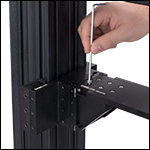
Click to Enlarge
Six M4 cap screws are included with each angle bracket to connect with arms.
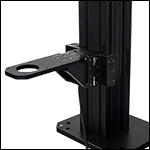
Click to Enlarge
The motorized module and angle bracket positions the optical port of the arm at a 7.74" throat depth. Here, the CSA2100 is shown mounted to the PLSZ1 angle bracket and connected to the PLSZ focusing module.
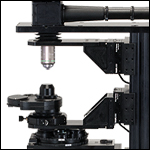
Click for Details
The PLSZ module has two possible orientations, creating space along the optical path for mounted optomechanical assemblies.
When using the PLSZ1 angle bracket with the PLSZ module, the surface of the arm will be flush with the bottom (or top) of the module.
When using the PLSZ2 angle bracket with the PLSZ module, the surface of the arm will be at the middle of the module.

| Compatible Stages |
|---|
| Translation Stages for Rigid Stands |
| Motorized Vertical Rigid Stand |
| Motorized Translating Breadboard |
| Microscope Body Translator |
| Motorized Focusing Module |
| Controller Specifications |
|---|
| Compatible Motor Specifications |
|---|
- Designed for Cerna Components with Stepper Motors
- Provides Control for up to Three Channels
- Separately Available Three-Knob Joystick Allows Hand Operation
- Each Axis can be Individually Disabled to Prevent Unintended Movements or to Retain a Position
- Dial on Top of Three-Knob Joystick Adjusts Translation Speed
The MCM301 3-Axis Controller is designed for use with the Thorlabs components listed in the table to the right. The MCMK3 3-Knob Joystick, available separately, can be connected to provide hand-operation. The controller can also be operated remotely using standalone software.
Each side face of the optional MCMK3 joystick includes a rotating knob and a push-button switch that are dedicated to a single axis. The push-button switch on the joystick enables and disables the axis and is lit in green when the axis is enabled. Disabling the axis lets the user preserve a position or prevent accidental movements. A dial on the top face adjusts the velocity per rotation of the knobs. For more information on the MCMK3 joystick and how to utilize the USB HID protocol, please see the full web presentation.
Since each MCM301 controller has three channels, you only need to purchase enough channels for each of the modules you intend to drive. For example, a Cerna microscope equipped with a PLSZ Motorized Focusing Module (which has one axis) and a PLSXY Translation Stage (two axes) would only require one MCM301 controller.
For more information, as well as compatible software and a LabVIEW™/C++/Python SDK, please see the full web presentation for the MCM301 controller.

- Provide Arrays of Mounting Holes for Creating DIY Microscope Modules
- Positioned by Sliding Along the Microscope Body Rail
- Drop-On Rail Carriages: Insert and Remove Anywhere Along the Vertical Rail
- XT95P12(/M) Rail Plate: Insert at Rail End and Slide Along Rail
| Item # | Length | Number of Mounting Holes |
Mounting Hole Type | Locking Screw | Type |
|---|---|---|---|---|---|
| XT95RC1 | 1.00" | 7 | 1/4"-20 Tapped | 1/4"-20 (3/16" Hex) |
Drop-On Rail Carriage |
| XT95RC2 | 2.00" | 21 | |||
| XT95RC3 | 3.00" | 35 | |||
| XT95RC4 | 4.00" | 49 | |||
| XT95RC1/M | 25.0 mm | 7 | M6 x 1.0 Tapped | M6 (5.0 mm Hex) |
|
| XT95RC2/M | 50.0 mm | 21 | |||
| XT95RC3/M | 75.0 mm | 35 | |||
| XT95RC4/M | 49 | ||||
| XT95P12 | 3.15" | 17 Threaded, 4 Counterbore |
1/4"-20 Tapped, 1/4" Counterbore |
Four 1/4"-20 (3/16" Hex) |
Rail Plate |
| XT95P12/M | 81.3 mm | M6 x 1.0 Tapped, M6 Counterbore |
Four M6 (5.0 mm Hex) |
These mounting platforms can be used to mount home-built microscope modules to the 95 mm dovetail on a Cerna microscope body. Each platform includes a matrix of mounting holes for compatibility with our extensive selection of optomechanics.
The Drop-On Rail Carriages can clamp to the side of a 95 mm rail by tightening the side-located 1/4"-20 (M6) locking screws. When the locking screw is loosened, the assisted opening mechanism pushes the hinged clamping arm out and provides ample clearance for the dovetail of a 95 mm rail. This allows the carriage to be inserted and removed anywhere along an exposed rail side. Furthermore, while the carriage is clamped onto a rail, the locking screw can be loosened slightly, allowing the carriage to slide along the rail edge and be repositioned in another location.
In comparison, the XT95P12(/M) Rail Plate includes a closely packed array of seventeen 1/4"-20 (M6) tapped holes and four 1/4" (M6) counterbores. Tightening the four included 1/4"-20 (M6) cap screws locks the rail plate in place. As shown in the image to the far right, these cap screws are attached to two T-Nuts that fit into the channels on the 95 mm dovetail. Because accessing these channels on a DIY Cerna microscope body requires the end of the rail to be available, the top plate of the body must be detached in order to install and remove this plate. We therefore only recommend this rail plate for microscope bodies without epi-illumination arms. It is difficult to reinstall and realign an epi-illumination arm that has an optical setup on it.
If using a rail carriage and rail plate in the same setup, please note that the distance between the mounting surface and the top of the rail will not be the same, as shown in this photo.

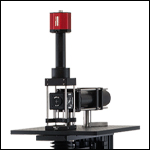
Click for Details
CSA3000 Used to Mount a Custom Epi-Illuminator and Widefield Viewing Apparatus with a sCMOS Camera

Click for Details
CSA3010 Used to Mount a Custom Epi-Illuminator and Widefield Viewing Apparatus with a sCMOS Camera
- Male D1N Dovetail on Bottom for Attachment to DIY Cerna Microscope Bodies
- Available in Two Sizes in Imperial and Metric Versions:
- Imperial: 14.00" x 11.00" or 18.00" x 4.60"
- Metric: 350.0 mm x 275.0 mm or 450.0 mm x 116.8 mm
- 1/4"-20 or M6 x 1.0 Mounting Holes

Click to Enlarge
Each breadboard has a male D1N dovetail on the bottom.
These black-anodized aluminum breadboard tops support user-designed widefield viewing apparatuses, epi-illumination pathways, and laser scanning pathways on top of upright Cerna microscopes. Each contains a Ø1.5" (Ø38.1 mm) through hole that is centered on a male D1N dovetail. This dovetail allows the breadboard to be connected directly to the epi-illumination arm of the microscope body, and it can also be used to stack the breadboard on top of an epi-illumination module. Additional details on the dovetail are available in the Microscope Dovetails tab.
The breadboards are available in two sizes. The larger version [Item # CSA3000(/M)] provides additional work surface, but protrudes past the sides of the epi-illumination arm, which may restrict approach angles around the objective for micromanipulators. The smaller version [Item # CSA3010(/M)] does not restrict approach angles and also has eight 4-40 taps around the Ø1.5" through hole for 30 mm and 60 mm cage systems.
In configurations where the breadboard is mounted directly on top of the epi-illumination arm, four M4 counterbores can be used to provide additional mounting stability.

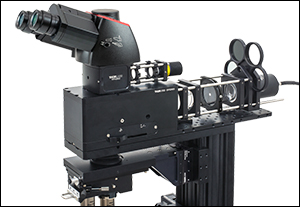
Click to Enlarge
Here, a white-light illumination path has been connected to the OPX2400 using our 60 mm cage system, and a GFP fluorescence path has been mounted on top of the OPX2400 via our WFA2002 epi-illuminator module.
- Two-Position Slider to Combine or Switch Between DIY Optical Paths
- Slider has Internal SM2 Threads and Holds One 35 mm x 52 mm x 3 mm Optic
- Back Port has Internal SM2 Threads and Four 4-40 Taps for Our 60 mm Cage System
- Imperial and Metric Versions
- OPX2400: 10.16" x 3.94" Breadboard with Double-Density 1/4"-20 Tapped Holes
- OPX2400/M: 258 mm x 100 mm Breadboard with Double-Density M6 x 1.0 Tapped Holes
- Stackable Design with Female and Male D1N Dovetails on Top and Bottom, Respectively
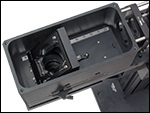
Click to Enlarge
Slider Located Above Objective
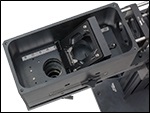
Click to Enlarge
Slider Not in Optical Path with Objective
The lid of the slider housing is opened by removing four cap screws with a 3 mm balldriver. The slider and the slider housing are internally SM2-threaded. Two stainless steel tracks and detents provide repeatable positioning.
The OPX2400(/M) Breadboard Top with Two-Position Slider adds a manually operated optic slider to the epi-illumination arm of a Cerna microscope body. By mounting a dichroic, beamsplitter, or mirror into the slider, users may combine or switch between widefield viewing, epi-illumination, and/or laser scanning pathways.
The optic slider has a clear aperture of Ø1.65" (Ø41.9 mm) and uses a leaf spring to retain a rectangular optic (minimum size: 34.9 mm x 51.9 mm x 2.8 mm; maximum size: 35.0 mm x 52.0 mm x 3.2 mm); the large aperture and optic size make this ideal for applications requiring large area scanning. It has internal SM2 (2.035"-40) threads that face the back of the stationary housing, allowing a tube lens to be installed at a fixed distance from the dichroic. The back of the housing also has internal SM2 threads, as well as four 4-40 taps spaced for our 60 mm cage system.
In addition, a breadboard with sixty-eight 1/4"-20 (M6 x 1.0) through-tapped holes in a double-density hole pattern is included to support a home-built optical path. More 1/4"-20 (M6 x 1.0) tapped holes (sixteen on the imperial version and eighteen on the metric version) are located on the sides of the breadboard. Measured from the top of the breadboard, the beam height is 50.0 mm. Thorlabs manufactures Ø12 mm pedestal posts that center many of our 30 mm and 60 mm cage plates at this beam height, as illustrated in this photo, which provide structural support for large or heavy setups.
Thorlabs offers a 750 nm shortpass dichroic (Item # DMSP750B) and a protected silver mirror (Item # PFR14-P02) as stocked items. Beamsplitters and dichroics at additional cutoff wavelengths are available by contacting Tech Support. Once the optic is mounted, a 5/64" (2 mm) hex balldriver can be used to fine tune the optic slider's pitch and yaw adjusters. The slider may be locked in either position by tightening the included locking screw with a 3/32" balldriver. In the photo to the upper right, the locking screw is installed in the forward position.
In laser scanning Cerna systems, we recommend attaching the tube lens using the internal SM2 threads on the slider, since this will maximize the distance available along the throat depth to mount the objective and, if desired, non-descanned detectors.

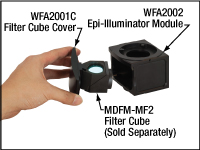
Click to Enlarge
The front of the module has a magnetic door cover that holds an MDFM-MF2 filter cube.
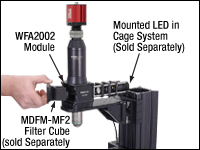
Click to Enlarge
The photo above shows a home-built epi-illumination path mounted on the WFA2002 via a 30 mm cage system.
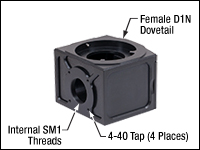
Click to Enlarge
The back of the WFA2002 module has internal SM1 threads and four 4-40 taps for our 30 mm cage system.
- Internal SM1 (1.035"-40) Threads, Four 4-40 Taps for 30 mm
Cage Systems, and Female and Male D1N Dovetails - Magnetic Door Cover Holds Filter Cube in Optical Path
The WFA2002 Epi-Illuminator Module holds one filter cube in the epi-illumination pathway of a DIY Cerna system. With a female D1N dovetail on top and a male D1N dovetail on the bottom, it is designed to mate with the epi-illumination arm of a Cerna microscope body, as well as with other epi-illuminator modules. Additional details on dovetails are available in the Microscope Dovetails tab.
As shown in the image to the right, its optical input port has internal SM1 (1.035"-40) threads and four 4-40 taps for our 30 mm cage system. These mechanical interfaces enable Thorlabs' extensive selection of SM1 and 30 mm cage components to be used to build custom epi-illumination paths.
The module includes a magnetically secured cover that can be connected to an MDFM-MF2 Filter Cube, manufactured by Olympus. The animation to the left shows the filter cube installation procedure. Extra covers, which the user can attach to the filter cubes to speed up filter cube exchange, are sold as Item # WFA2001C. These filter cubes can be used to hold fluorescence filter sets, beamsplitters with crossed polarizers, or mirrors.
We also offer the WFA2001 Epi-Illuminator Module, which ships ready to accept an uncollimated light source with a Ø3 mm core liquid light guide or an SM1-coupled output.

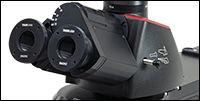
Click to Enlarge
Two SM2N2 adapters attached to the trinocular eyepieces.
- Replace Trinocular Eyepiece for DIY Construction
- Compatible with SM1, SM2, and 30 mm Cage Construction Systems
The SM2N2 Eyepiece Adapter allows custom-built optical detection systems to attach to either eyepiece on the trinoculars of a Cerna Microscope. This adapter replaces the lens element on the eyepiece that sets the image plane at the the back of the eyes (see image to the right). Five alignment slots ensure the adapter fits snugly inside the eyepiece without rotation; because of the drop-in nature of this adapter, take care the attached system does not overbalance the 40 g eyepiece adapter when it is inside the trinoculars.
This adapter features internal SM1 (1.035"-40) threading for Ø1" lens tubes; two SM1RR retaining rings are included to secure an optic inside the adapter. The adapter also has external SM2 (2.035"-40) threading for Ø2" lens tubes. The face with the item # engraving has 4-40 tapped holes for 30 mm cage systems.

- Extend Versatility of Our Lens Tube and Cage Construction Systems to DIY Cerna Systems
- Compatible with DIY Cerna Modules that Have D1N, D2N, D2NB, D3N, D1T, D3T, or D5Y Dovetails
The items shown here represent our complete selection of dovetail adapters for Thorlabs' Cerna microscopy platform. They integrate the Cerna platform with our SM1 (1.035"-40) lens tube, SM30 (M30.5 x 0.5) lens tube, SM2 (2.035"-40) lens tube, 30 mm cage, and 60 mm cage construction systems, making them ideal for creating custom widefield viewing, epi-illumination, trans-illumination, and condenser mounting apparatuses. Additionally, the WFA4111 and SM2A59 adapters feature internal M38 x 0.5 and SM2 threads, respectively, that can directly accept one of our infinity-corrected tube lenses. We also offer the LCPN3 and LCPY3 trinocular port adapters, designed to allow Olympus trinoculars that have a male D5Y dovetail to be used with DIY Cerna systems. See the images and table below for application ideas and the adapters' mechanical features.
The D1N, D2N, and D2NB dovetails are primarily used by our widefield viewing and epi-illumination accessories, while the D1T dovetail is used with our Cerna nosepiece accessories. The D3N is Thorlabs' designation for the dovetail used by the majority of Nikon condensers for upright microscopes, and the D3T dovetail is compatible with our CSE2100 epi-illuminator module. Lastly, the D5Y is Thorlabs' designation for the dovetail used by the majority of Olympus widefield viewing modules.
Application Ideas
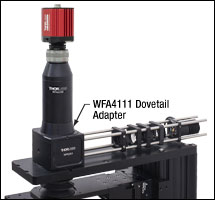
Click to Enlarge
Here, our WFA4111 D1N Adapter is being used to support an SM2 lens tube that contains user-selected optics for forming an image on a Scientific Camera.
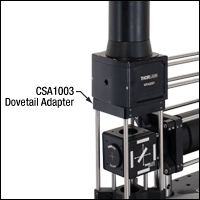
Click for Details
In this photo, the CSA1003 D1N Adapter is connecting a 60 mm cage system to a WFA2002 Epi-Illuminator Module.
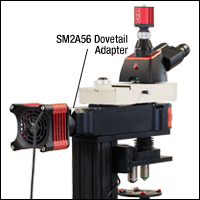
Click to Enlarge
In this setup, the SM2A56 D2N Adapter is connecting a Solis® high-powered LED to the back of a CSE2100 epi-illuminator module.
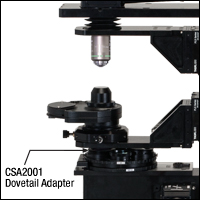
Click to Enlarge
Our CSA2001 D3N Adapter is used by our CSA2000 Condenser Arm to hold a condenser to our CXY2A Translation Mount. This mount provides orthogonal XY adjusters for the condenser.
 Products Home
Products Home



















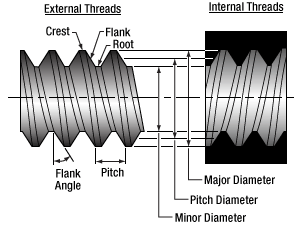
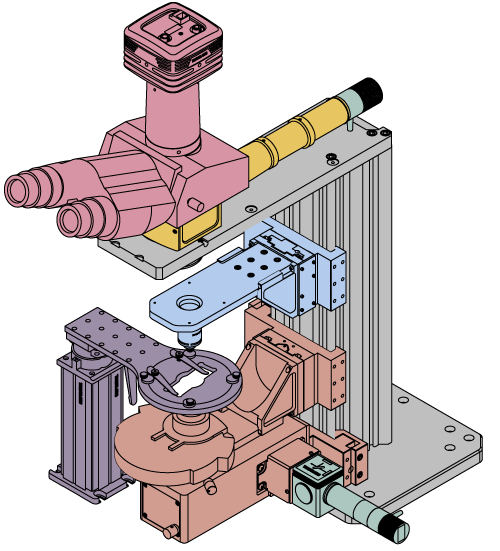























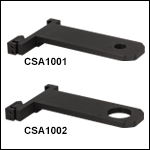
 Zoom
Zoom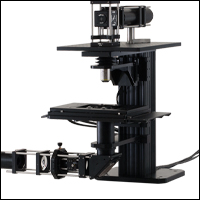
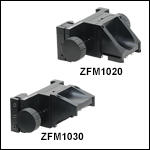
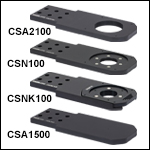
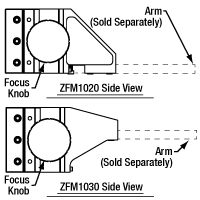
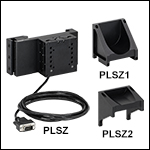

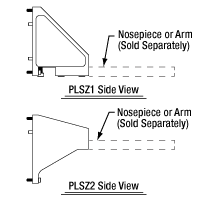
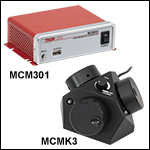
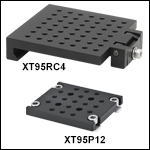
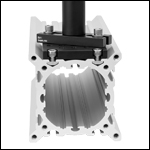
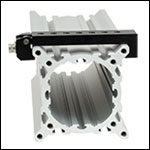
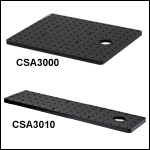
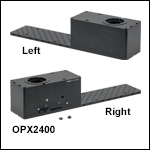
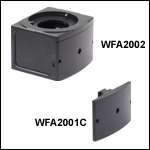
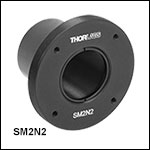
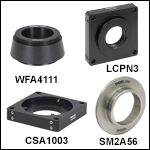
 Body Attachments & Extensions
Body Attachments & Extensions